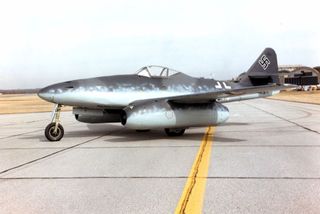First Fighter Jet: Me 262 Schwalbe | The Most Amazing Flying Machines Ever

This is part of a SPACE.com series of articles on the Most Amazing Flying Machines Ever, the balloons, airplanes, rockets and more that got humans off the ground and into space.
U.S. military intelligence raced to capture Nazi Germany's secret weapons and rocket scientists during the last days of World War II. One of those secret weapons, the Messerschmidt Me 262 Schwalbe ("Swallow"), represented the world's first operational turbojet aircraft and fighter jet.
The Me 262 arrived too late to change the European air war dominated by Allied bombers and fighters. But the fighter jet's swept wings and turbine engines gave it an unmatched speed of 540 mph (869 kph) — making it 120 mph (193 kph) faster than the propeller-driven P-51 Mustang that represented the best U.S. fighter aircraft.
Germany's fighter jet first hit the drawing boards in 1938 and made a first jet-powered flight in 1942 during the first half of World War II. But a long delay in jet engine development prevented it from entering combat perhaps as early as 1943. [Secret Weapons of the Third Reich]
Historians previously blamed the delay on Adolf Hitler's order to build a bomber version of the Me 262. But the Smithsonian's National Air and Space Museum points to the troubled jet engine development as the main culprit, even though the bomber project diverted 30 percent of the fighter jet's airframes.
The Me 262's advantages became obvious to both German and Allied pilots when it finally entered combat on July 25, 1944. The fighter jet's four 30-millimeter cannons also allowed it to tear up any bomber or fighter in its targeting sights, and it could also carry R4M "Hurricane" rockets to fire at slower Allied bombers and break up their flying formations.
German pilots flying the Me 262 eventually claimed 502 air victories versus 102 losses. The fighter jet performed as well or better than Allied fighter jets that debuted very late in the war — the British Gloster Meteor fighter jet and U.S. Lockheed P-80, according to Air Force Magazine.
But fewer than 300 of more than 1,400 Me 262s produced ended up flying into combat. U.S. bombers destroyed hundreds of Germany's jet fighters on the ground as they bombed both factories and airfields. By the end, the last Me 262 units had to fly out from temporary bases built on Germany's autobahn highways because the airfields lay in ruins.
Many Me 262s never even reached frontline squadrons because Germany's ground transportation was virtually destroyed near the end of World War II. A lack of fuel, spare parts and trained pilots similarly crippled the Me 262's possible impact on the war.
The U.S. military captured at least nine Me 262s and recruited several German pilots who could fly them. That ensured the Me 262's legacy would live on by influencing the earliest generations of the U.S. military's own jet aircraft.
— Jeremy Hsu, SPACE.COM Senior Writer
Related:
The Greatest Moments in Flight
- The First Hot-Air Balloon
- The First Powered Airship
- The Wright Brothers & the First Flight
- World's First Commercial Airline
- Charles Lindbergh & the First Solo Transatlantic Flight
- Breaking the Sound Barrier
The Most Amazing Flying Machines Ever
- The First Airplane: Wright Flyer
- The Red Baron & Aerial Weapons of World War I
- The Zeppelin Hindenburg: When Airships Ruled
- SR-71 Blackbird: Supersonic Spy Aircraft
- Saturn V Rocket & Apollo Spacecraft
Image galleries:
Join our Space Forums to keep talking space on the latest missions, night sky and more! And if you have a news tip, correction or comment, let us know at: community@space.com.
Get the Space.com Newsletter
Breaking space news, the latest updates on rocket launches, skywatching events and more!
Jeremy Hsu is science writer based in New York City whose work has appeared in Scientific American, Discovery Magazine, Backchannel, Wired.com and IEEE Spectrum, among others. He joined the Space.com and Live Science teams in 2010 as a Senior Writer and is currently the Editor-in-Chief of Indicate Media. Jeremy studied history and sociology of science at the University of Pennsylvania, and earned a master's degree in journalism from the NYU Science, Health and Environmental Reporting Program. You can find Jeremy's latest project on Twitter.
